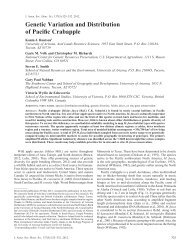CONSERVATION
Conservation You Can Taste - The Southwest Center - University of ...
Conservation You Can Taste - The Southwest Center - University of ...
- No tags were found...
You also want an ePaper? Increase the reach of your titles
YUMPU automatically turns print PDFs into web optimized ePapers that Google loves.
FRUITS, NUTS, & BERRIES<br />
THE NUMBER of orchards maintained in the U.S. has suffered a precipitous<br />
decline over the last century. For example, there were over 200 million apple trees in<br />
home and commercial orchards in the U.S. a century ago, and by 1950, there were<br />
less than 50 million apple trees left in the U.S. Today there are only 7500 commercial<br />
apple orchards in the country, and their acreage has declined by 15% since 1997.<br />
Today, 90 percent of all apples sold in chain grocery stores in our country come from<br />
just 11 varieties of the 3000 varieties still available through on-line sources or catalogs.<br />
Six of the major apple juice producers in the U.S. have gone out of business since<br />
2001, leaving only two U.S.-based companies to compete with China for providing<br />
our populace with both apple juice and frozen puree. Similar statistics could be<br />
offered for other fruits and nuts.<br />
Despite such consolidation and outsourcing, there were at least 275 fruit, nut and<br />
berry nurseries companies with catalogs or on-line listings in the U.S. and Canada by<br />
2009, up from 248 companies in 1987. These 275 inventories offer over 8750 fruit,<br />
nut and berry varieties to American and Canadian orchard-keepers in North America<br />
today.<br />
While hundreds of independently-owned nurseries have closed their gates due to<br />
the proliferation of “psuedo-nursery” garden centers attached to big box stores, other<br />
modes of fruit and nut tree exchange have emerged. Today, thousands of orchardkeepers<br />
come to exchange scion wood and learn grafting techniques at seasonal events<br />
sponsored by the Home Orchard Society in the Northwest, MOFGA in Maine, the<br />
Worcester County Horticultural Society in Massachusetts, the Midwestern Fruit<br />
Explorers, and California Rare Fruit Explorers.<br />
The driving factor that appears most important to the re-diversification of fruit<br />
and nut orchards is the opportunity to access taste options not available in a few<br />
standard varieties; adding diversity to home orchards with urban and suburban areas<br />
is also catching wind. These taste options not only include the flavor profiles of fresh<br />
dessert apples, but a revival of hard cider and fruit brandy making in the United<br />
40



